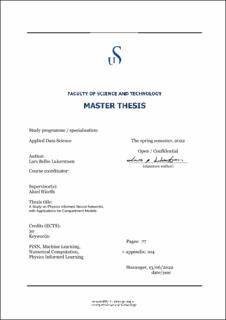A Study on Physics Informed Neural Networks, with Applications for Compartment Models
Master thesis
Permanent lenke
https://hdl.handle.net/11250/3032549Utgivelsesdato
2022Metadata
Vis full innførselSamlinger
- Studentoppgaver (TN-IDE) [866]
Sammendrag
The main goal of this thesis was to investigate the methodology of Physics InformedNeural Networks (PiNN), as a computational tool leveraging differential equationsas a regularization for a learning task. PiNN is a new field of research and thereforeparticular concern was given to the task of obtaining an understanding of themethod, gauging benefits, performance, and appropriateness in relation to establishedmethods. In order to develop this knowledge, the methodology was implementedand applied through four case studies, three of which demonstrates achievementsalready supported by the literature. In addition case three incorporates a thoroughtesting scheme, scoping out PiNNs’ capabilities of parameter discovery andregularization. From this a larger framework is developed. In case four, the frameworkis utilized applying of the method of PiNN in a real world biomedical context,realized as a model of the circulatory system. The implementations were realized ina bottom up approach utilizing the neural network capabilities of PyTorch. Overall,the findings of the thesis support the established findings of previous literature inregards to performance and capabilities. Additionally, important details in regardsto implementation and solution validity is highlighted, addressing the conditionsnecessary for the optimal use of PiNN as a methodology.
